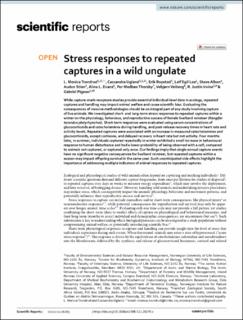| dc.contributor.author | Trondrud, Liv Monica | |
| dc.contributor.author | Ugland, Cassandra Regine | |
| dc.contributor.author | Ropstad, Erik | |
| dc.contributor.author | Loe, Leif Egil | |
| dc.contributor.author | Albon, Steve | |
| dc.contributor.author | Stien, Audun | |
| dc.contributor.author | Evans, Alina | |
| dc.contributor.author | Thorsby, Per Medbøe | |
| dc.contributor.author | Veiberg, Vebjørn | |
| dc.contributor.author | Irvine, R. Justin | |
| dc.contributor.author | Pigeon, Gabriel | |
| dc.date.accessioned | 2022-11-18T07:21:29Z | |
| dc.date.available | 2022-11-18T07:21:29Z | |
| dc.date.created | 2022-11-02T12:58:50Z | |
| dc.date.issued | 2022 | |
| dc.identifier.citation | Scientific Reports. 2022, 12 , . | en_US |
| dc.identifier.issn | 2045-2322 | |
| dc.identifier.uri | https://hdl.handle.net/11250/3032677 | |
| dc.description.abstract | While capture-mark-recapture studies provide essential individual-level data in ecology, repeated captures and handling may impact animal welfare and cause scientific bias. Evaluating the consequences of invasive methodologies should be an integral part of any study involving capture of live animals. We investigated short- and long-term stress responses to repeated captures within a winter on the physiology, behaviour, and reproductive success of female Svalbard reindeer (Rangifer tarandus platyrhynchus). Short-term responses were evaluated using serum concentrations of glucocorticoids and catecholamines during handling, and post-release recovery times in heart rate and activity levels. Repeated captures were associated with an increase in measured catecholamines and glucocorticoids, except cortisone, and delayed recovery in heart rate but not activity. Four months later, in summer, individuals captured repeatedly in winter exhibited a small increase in behavioural response to human disturbance and had a lower probability of being observed with a calf, compared to animals not captured, or captured only once. Our findings imply that single annual capture events have no significant negative consequences for Svalbard reindeer, but repeated captures within a season may impact offspring survival in the same year. Such unanticipated side effects highlight the importance of addressing multiple indicators of animal responses to repeated captures. | en_US |
| dc.language.iso | eng | en_US |
| dc.publisher | Springer Nature | en_US |
| dc.rights | Navngivelse 4.0 Internasjonal | * |
| dc.rights.uri | http://creativecommons.org/licenses/by/4.0/deed.no | * |
| dc.title | Stress responses to repeated captures in a wild ungulate | en_US |
| dc.title.alternative | Stress responses to repeated captures in a wild ungulate | en_US |
| dc.type | Peer reviewed | en_US |
| dc.type | Journal article | en_US |
| dc.description.version | publishedVersion | en_US |
| dc.source.pagenumber | 15 | en_US |
| dc.source.volume | 12 | en_US |
| dc.source.journal | Scientific Reports | en_US |
| dc.source.issue | 1 | en_US |
| dc.identifier.doi | 10.1038/s41598-022-20270-z | |
| dc.identifier.cristin | 2067987 | |
| dc.source.articlenumber | 16289 | en_US |
| cristin.ispublished | true | |
| cristin.fulltext | original | |
| cristin.qualitycode | 1 | |

